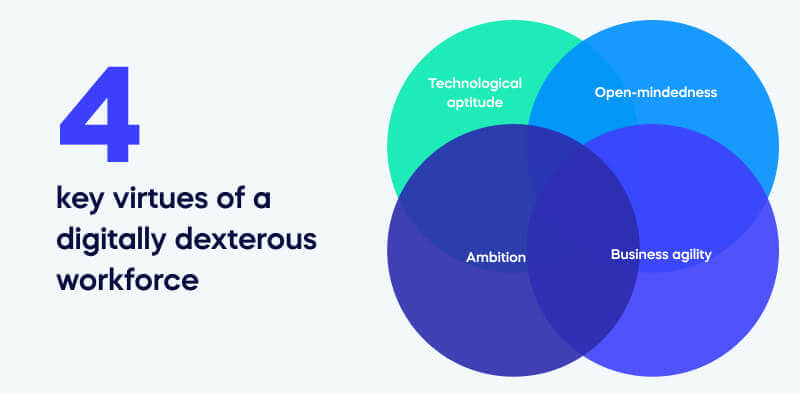What’s the biggest threat to your digital transformation success?
It’s widely understood that employee resistance to change has the power to thwart even the most strategic organizational change efforts.
In your pursuit of digital transformation, you’re likely relying on a variety of approaches to encourage employees to embrace change and make the most of digital investments.
But there is one key ingredient that often slips through the cracks: digital dexterity. Without this critical competency, employees will never fully maximize the value of enterprise technology, and resistance will persist.

Digital dexterity is fundamental to successful digital change and organizational transformation. But how do you cultivate it, and who’s in charge?
Digital dexterity: A prerequisite to digital transformation success
Digital dexterity is the desire and ability of employees to embrace existing and emerging technologies to achieve better business outcomes. It’s a matter of both attitude and skills.
It’s important for a few reasons:
- Digital technology is developing at a rapid pace, which means more advanced tools will find their way into the modern workplace.
- An ever-increasing share of employees’ work is being performed on digital tools and platforms.
- Business strategies rely on digital capabilities to optimize internal operations and provide a better customer experience.
We often speak of the importance of achieving digital adoption: reaching a state in which employees have the ability to use digital tools as they are intended and to the fullest extent. Instead of settling for a handful of basic features, we want employees to have the ability to maximize the full range of capabilities and complete advanced business processes.
This is what true digital transformation success looks like.
BUT, unless you can successfully cultivate this competency of digital dexterity, it will be impossible to realize digital adoption.
Dive Deeper: Digital Transformation 2.0 — What’s Holding You Back?
Who needs to own digital dexterity?
Developing a digitally dexterous workforce is essential for thriving in the current business landscape. But the question of who should be in charge stumps many organizations.
It’s easy to reason that IT should take the lead because of the technology aspect. But while IT might be the most technologically adept, promoting an organization-wide attitude shift isn’t exactly in their realm of expertise.
Others see this as a job for HR. After all, encouraging employees to embrace a new mindset and pursue digital skills development is very much a people issue. Still, others think individual business units must create their own efforts to promote digital dexterity.
HR in the lead

Here at WalkMe, we fall under the second camp — with a caveat. HR should spearhead initiatives to develop digital dexterity, but it’s not their responsibility alone.
While HR leaders are in the best position to plant the seed for developing an organization-wide competency around digital dexterity, individual business units must make these efforts come to life.
HR functions as each department’s most judicious business partner. They are there to fulfill evolving needs for talent, workforce development, and employee support. HR can also help facilitate better coordination across typically siloed business units.
But team leaders and managers have the closest and most frequent interactions with employees. It is only by addressing their individual needs, goals, and concerns can you build a digitally dexterous workforce.
4 key virtues of a digitally dexterous workforce
Here are the most important traits and capabilities of digitally dexterous organizations.
1. Technological aptitude
As the pace of technological development continues to accelerate, employees who demonstrate the ability to learn and exploit evolving digital tools will also be among the most dexterous.
The area where this matters most is the increasing prevalence of cloud-based SaaS apps. Compared to on-premise IT platforms that require IT-led updates every few years, apps delivered through the cloud unveil new features and capabilities on a routine basis.
Without a digitally dexterous workforce, it will be difficult to reap the full value of developing capabilities. Boosting technological acumen across the board is a must, which often means adopting an evolved approach to software onboarding and employee training.
2. Open-mindedness
Like all organizational change initiatives, getting employees to develop an authentic interest in developing their own digital dexterity requires an open mind. Employees who resist change and cling to the status quo will prevent you from achieving dexterity on a broad scale.
If digital dexterity is the precursor to digital adoption, then an open mind is the precursor to digital dexterity. This is one area where strong leadership is critical. HR must provide clear and open communication about the need to become “digital-ready,” including how this competency will support business and employee development goals.
Without strong leadership, overcoming resistance and encouraging employees to embrace efforts to become dexterous will be much more difficult.
Like what you’re reading? Subscribe to the blog for top insights delivered right to your inbox!
3. Business agility

Businesses that have cultivated a high level of digital dexterity also tend to exhibit much greater flexibility than those that lack it.
Taking an agile approach to organizational design, business strategy, and workforce development can help you boost dexterity exponentially. For example, when business units have the ability to pivot their strategies in response to external market forces without needing to wade through lengthy bureaucratic approval processes, they have the potential to seize more competitive opportunities.
Likewise, identifying which emerging technologies will support your goals — and the ability to seamlessly integrate them into employee workflows — is essential.
4. Ambition
Finally, you need ambitious employees to become dexterous. Staff who understand how business is evolving and want to develop greater digital skills will be instrumental in driving your organization forward.
Once employees see how digital dexterity can unlock new opportunities and boost their individual career growth, their motivation to learn and embrace new digital tools is guaranteed to rise.
Cultivating authentic ambition may seem hard. But by adopting solutions that make using digital tools easier, the stress associated with learning new platforms is quickly replaced with excitement.
Are you providing the right support?
Creating the framework to cultivate digital dexterity requires solid leadership and support. HR must drive the initiative forward, while team leaders should make addressing individual employee needs a priority.
This comes in the form of mentorship, clear communication, and importantly, more effective software onboarding. When reaping the greatest value from digital tools is the goal, facilitating ease of use is a no-brainer.
Making enterprise technology easy to use and eliminating barriers to entry enables you to acquire each of the four main traits of digitally dexterous organizations: it increases employees’ capacity to use digital tools, lowers resistance, promotes agility, and raises motivation.
WalkMe’s Digital Adoption Platform (DAP) transforms the user experience in today’s overwhelming digital world. Using artificial intelligence, engagement, guidance, and automation, WalkMe’s transparent overlay assists users to complete tasks easily within any enterprise software, mobile application or website. Discover how a DAP can revolutionize your business.

